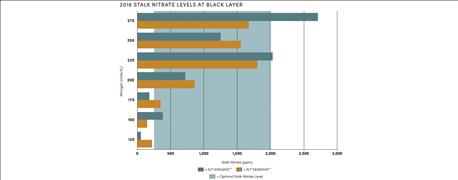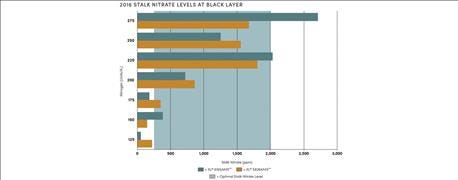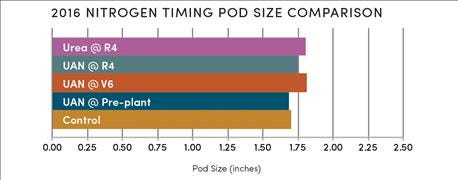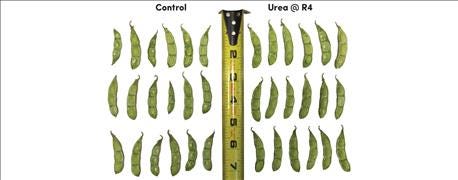December 20, 2016

Both corn and soybeans require high levels of nitrogen (N) for production. Due to the mobile nature of N, ideal rates and timing will vary from one year to the next as well as from one environment to another. Understanding the importance of N, Beck’s Practical Farm Research (PFR)® team continues to conduct research on the Economic Optimum Nitrogen Rates (EONR) in both a corn after corn (CAC) and corn after soybean (CAS) rotation every year. Additionally, Beck’s PFR continues to test N timing in soybeans to find the best source with the best return on investment (ROI).
 2016 Beck’s Ohio PFR Nitrogen Rate Study – Corn After Corn. Stalk nitrate levels at black layer.
2016 Beck’s Ohio PFR Nitrogen Rate Study – Corn After Corn. Stalk nitrate levels at black layer.
In both CAC and CAS rotations, Beck’s PFR used a N efficient hybrid and a hybrid with a high N response. In both studies, 30 units of N was applied 2x2, and the remaining N was applied as a V3 sidedress. The total N applied in the CAC study ranged from 125 to 275 units, in increments of 25 units. The total N applied in the CAS study ranged from 100 to 250 units, also in increments of 25 units. A N efficient hybrid, XL® 5828AMX™*brand was tested as was the high N response hybrid XL® 6165AMX™*brand. In the 2016 Ohio PFR CAC Study, Beck’s agronomists noted that the stalk nitrate results showed adequate nitrate remaining in stalk samples at black layer. Of the rates tested, N was not a limiting factor when 200 units/A. or more of N was applied in a CAC setting in Ohio.
 2016 OH PFR Nitrogen Timing Study — On average, the largest pod size was noted in the urea application at R4 and the UAN 28% application at V6.
2016 OH PFR Nitrogen Timing Study — On average, the largest pod size was noted in the urea application at R4 and the UAN 28% application at V6.
In the CAS study, yields increased with an increase in N applied up to the highest rate. This suggests that the addition of N would have resulted in higher yields. However, the greatest ROI was seen with the rate of 175 units of N, regardless of hybrid. This related well to stalk nitrate data which showed 175 units of N to be in the adequate zone of nitrate remaining in corn stalks at the end of the season.
In the case of N timing in soybeans, the test plot received a total of four N applications, compared to a control. The N applications tested included 30 units of UAN 28% at pre-plant, 30 units of UAN 28% at V6, 30 units of UAN 28% at R4, or 30 units of Urea at R4. Beck’s agronomists noted differences when observing both pods and pod fill in this study during the season. On average, the largest pod size was noted in the urea application at R4 and the UAN 28% application at V6 (graph shown). Pod fill was observed to be the greatest in the urea application at R4, and this held true with soybean yields. The urea application of N showed a 2.6 Bu./A. increase in yield with the application of urea at R4. This bump in yield was likely due to the timely rain event following the urea application.
For more information on Beck’s PFR, click here: www.beckshybrids.com/PFR
 A timely rain after the urea application at the R4 growth stage reduced N volatization and provided the most consistent pod size, pod fill, and return on investment.
A timely rain after the urea application at the R4 growth stage reduced N volatization and provided the most consistent pod size, pod fill, and return on investment.
Practical Farm Research (PFR)® is a registered trademark of Beck’s Superior Hybrids, Inc.
About the Author(s)
You May Also Like




